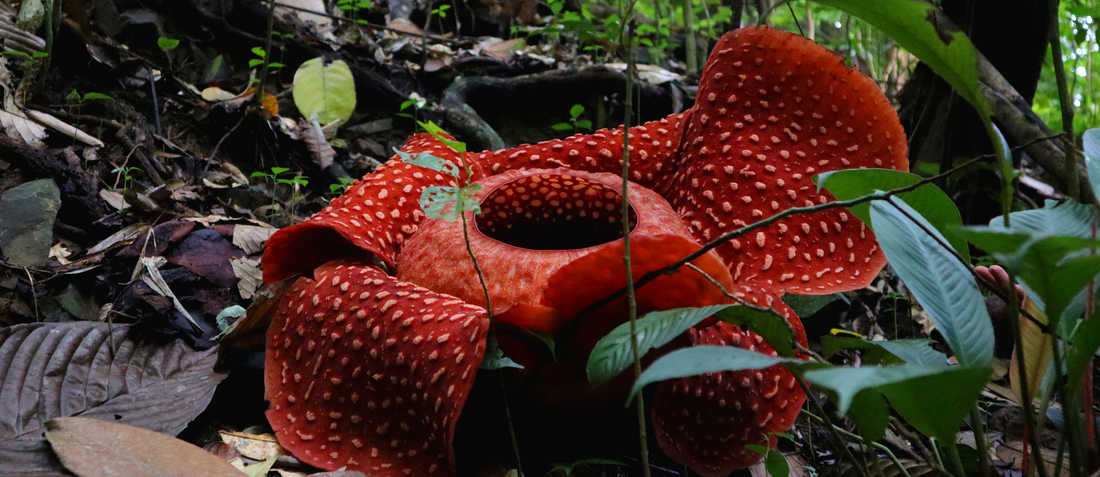
May: Indonesia's Corpse Flower

Rafflesia arnoldii is one of the three national flowers in Indonesia, the other two being the white jasmine and moon orchid. The plant is natively referred to as Bunga Bangkai, which means “Corpse Flower”. It was officially recognized as a national flower in Indonesia in 1993. Since its discovery, it has fascinated people across the globe for its sheer size and rarity but also for its unique genetic makeup that has dumbfounded scientists for decades.
Some Quick Taxonomy
 Depending on who you ask, this plant is not a flower nor a plant at all. It has no roots, shoots, stems, or leaves and doesn’t photosynthesize. It’s a parasite that attaches to its host for food, water and nutrients. This awe-striking flower is found in the rainforests of Indonesia, Malaysia, southern Thailand, and the southern Philippines. It can grow to be over 3 feet across and weigh more than 20 pounds.
Depending on who you ask, this plant is not a flower nor a plant at all. It has no roots, shoots, stems, or leaves and doesn’t photosynthesize. It’s a parasite that attaches to its host for food, water and nutrients. This awe-striking flower is found in the rainforests of Indonesia, Malaysia, southern Thailand, and the southern Philippines. It can grow to be over 3 feet across and weigh more than 20 pounds.
Lifecycle
The survival of Rafflesia relies on an exclusive parasitic relationship with the genus Tetrastigma, a woody vine in the grape family. The Corpse flower begins life as tendrils of tissue that weave through the inner parts of the vine, secretly stealing water and nutrients, similar to a fungus. Sometimes the tendrils are a single cell wide, but they can grow to be ten meters long. It takes 18 months for the tissue in the vine to create a small bud. The bud takes 6-9 months to mature into the size of a full cabbage when it can unfurl into the striking red and white bloom. That’s over two years of maturation! The bloom itself only lasts for a handful of days before dying away and ideally restarting the cycle.
This plant is able to reproduce both sexually and asexually. When it is pollinated, the research suggests that it relies on carrion flies which swarm to the flower because of its well-known putrid, rotting odor. The flies regularly feast on rotting carcasses, and this flower perfectly replicate the smell. The flies seek out the largest carcass they can find, which is one of the running theories on why this flower is so incredibly large.
Habitat destruction has isolated the population significantly, making it difficult and unlikely that male and female flowers bloom close enough to reach pollination. Thankfully the plant can reproduce asexually, but that stunts its genetic diversity.
 In some countries, the buds, prized for their medicinal properties, are sold at roadside stands.
In some countries, the buds, prized for their medicinal properties, are sold at roadside stands.An interesting note about the pollen itself is that it’s not powdery the way other pollen is; this is written about by professor of organismic and evolutionary biology Charles Davis. Rafflesia “produces a massive quantity of viscous fluid, sort of like snot, that dries on the backs of these flies—and presumably remains viable for quite a long time,” says David in his article on his research.
Medicine
Rafflesia bud extract has been studies as a would healing accelerant, and is very effective at helping to both clot and heal breaks in the skin. Indigenous peoples of northern Borneo believe that drinking Rafflesia tea after childbirth will flush the placenta and restore the figure. It’s also known for its high antioxidant levels, though people rarely use the plant medicinally anymore as its numbers dwindle. Though we don’t often feed on the flowers, many animals do. Tree shrews, squirrels, porcupines, and even leopards have been documented snacking on the flower and its buds.
Fun Facts
The ability of two organisms to produce offspring through sexual reproduction has been thought of as a near definition of a species. This plant completely upheaves that as it’s been found to use horizontal gene transfer. Studies of the Rafflesiaceae family have revealed an incredible case of horizontal gene transfer, in which the parasite “steals” genes from its host creating rich diversity in the plant without sexual reproduction. Researchers estimate that 2-3% of some Rafflesiaceae come from past and present host species, and at least 50% of its mitochondrial genes are from the host. One running theory is that this allows the plant to bypass their host’s defenses undetected.
 Charles Davis with (a rather modest) Rafflesia tuan-mudae in 2007, Gunung Gading National Park, Borneo.
Charles Davis with (a rather modest) Rafflesia tuan-mudae in 2007, Gunung Gading National Park, Borneo.

April 2024 -- our first corpse flower bloom of 2024 opened the evening of April 24. USBG
Thank you for joining us to explore Indonesia’s national flower! This was one of my favorite plants that I studied in college, and I hope to one day see (and smell) it in the wild.
There is still so much we don’t understand about this plant, but I think it’s safe to say it’s one of the most alien flowers we’ve come across.
-----------------------
Want to learn more? Checkout these sources!
https://www.loc.gov/everyday-mysteries/botany/item/what-is-the-largest-flower-in-the-world/
https://daily.jstor.org/plant-of-the-month-corpse-lily/
https://www.smithsonianmag.com/smart-news/can-horticulturalists-save-corpse-flower-180976816/
https://www.ncbi.nlm.nih.gov/pmc/articles/PMC2771251/
https://journals.sagepub.com/doi/10.1177/1940082918796011.
https://www.harvardmagazine.com/2017/02/colossal-blossom#:~:text=The%20buds%20and%20blooms%20are,placenta%20and%20restore%20the%20figure.